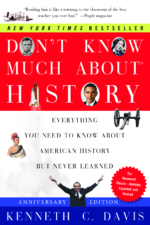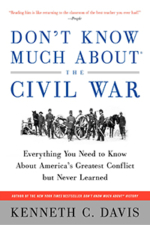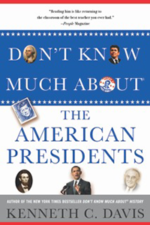(Originally posted July 13, 2020; revised and reposted August 20, 2022)
“The first documented arrival of Africans to the colony of Virginia was recorded by John Rolfe: About the latter end of August, a Dutch man of Warr of the burden of a 160 tunes arrived at Point-Comfort, the Comandors name Capt Jope, his Pilott for the West Indies one Mr Marmaduke an Englishman. … He brought not any thing but 20. and odd Negroes, w[hich] the Governo[r] and Cape Merchant bought for victuall[s].’ “
–National Parks Service, Historic Jamestown, “African Americans at Jamestown”
Whose history it is? And who gets to shape the narrative?
This is the hottest of hot potato questions, currently dominating the conversation about which dates we mark on the national calendar, whose statues we honor while others are pulled from their pedestals, and how we teach America’s past in our schools,
The comfortable, traditional American history so many Americans were once taught –sort of – has come down for centuries as a bedtime story. It is complete with a happy ending, a rousing tableau for a school pageant, or an instructive morality tale. Columbus’s first voyage and Washington’s cherry tree being Exhibits A and B.
Or it was the exclusive property of one powerful group that wanted to venerate its particular vision of pride. That was the reassuring tale of the first Thanksgiving Happy Meal, or Puritans arriving to establish a “shining city on a hill,” leaving out the indigenous and the dissidents –Roger Williams, Anne Hutchinson, Quakers, and Catholics—who were unwelcome on that hill.
The conflict between that traditional telling of history as American Exceptionalism and a so-called “revisionist” version is boiling over in the wake of the former president’s discordantly curdled speech at Mount Rushmore on the eve of Independence Day in 2020.
“Our nation is witnessing a merciless campaign to wipe out our history, defame our heroes, erase our values and indoctrinate our children…” (New York Times, July 3, 2020)
Back in 1790, John Adams, who was present at the creation, offered a gloomy prediction of how the story would be told.
“The history of our Revolution will be one continued lie from one end to the other,” he wrote fellow Declaration signer Benjamin Rush. “The essence of the whole will be that Dr. Franklin’s electrical rod smote the earth and out sprang General Washington…. thenceforward these two conducted all the policies, negotiations, legislatures and the war.” [1]
Adams was right. From the beginning, American history became a national myth. Controlling that narrative is a powerful tool. As Winston Churchill once remarked,
“History will bear me out, particularly as I shall write history myself.”[2]
How we tell history and then drape it over national holidays or erect monuments to a selective account has always been subject to somebody’s agenda. Winners write history –usually. They tailored the story that became the national narrative, or the myth, depending on your perspective. But for the United States that proud, patriotic portrait came at the cost of the whole truth. And it left far too many people out of the picture.
The history widely celebrated on the Glorious Fourth rightly hailed a document that secured the timeless verities of “All men are created equal” and that all are entitled to “life, liberty, and the pursuit of happiness.”
In crafting that laudable lesson, however, some inconvenient truths were swept into history’s dustbin. When it comes to Independence Day, that meant concealing America’s Great Contradiction – that a nation “conceived in liberty” was also born in shackles.
READ my essay “The American Contradiction” Social Education, March/April 2020
In the current moment of reckoning, there is another agenda. We now acknowledge the purchase of captive Africans in Jamestown in 1619. The Mount Vernon plantation dedicated to honoring the first president now openly confronts the fact that Washington had enslaved more than 300 people at Mount Vernon at his death in 1799. Similarly, Jefferson’s Monticello no longer conceals that the author of the Declaration enslaved people, including his own offspring, born of an enslaved woman.
That history is messy. And the true beauty of American history is that it is not a tale that can be told in simple terms. It is complicated and nuanced. There are few neat answers which fit in a bubble on a standardized test form.
For instance, it is pointless to teach how Washington won the Battle of Yorktown in October 1781 without acknowledging that his first order of business after the surrender was to return thousands of enslaved people who had sought refuge with the British –including those from his Mount Vernon and Jefferson’s Monticello.
It’s absurd to teach a “melting pot” myth and a “religious freedom” narrative without talking about the deep vein of dominant anti-immigrant and anti-Catholic sentiments in America’s past that produced such moments as Philadelphia’s 1844 “Bible Riots,” a deadly sectarian battle begun over which version of the Bible was used in public schools.
Those are also American history “facts.” And as John Adams also famously said,
“Facts are stubborn things…whatever may be our wishes and inclinations or the dictums of our passions…”
Adams said that as he was defending the “bad guys” –the British soldiers who shot at some Boston townies in what became heralded as the Boston Massacre. It is a reminder that America’s rebellion began with an assault on authority. Some snowballs and stones were chucked at those British soldiers. That was followed by act of vandalism and property destruction, now hailed as the Boston Tea Party. And then some rebels tore down a statue—that of King George III, in New York City on July 9, 1776. This is all hailed in the “winner’s history” so many have been taught for so long.
And those are extremely important American history lessons. The rock-throwers, the tea party vandals, and the riotous statue-topplers of the American Revolution were part of the unruly mob that sometimes changes history.
History doesn’t trickle down from the top. Most of the great social movements in this nation’s history came instead from the bottom up. Independence, abolition, suffrage, civil rights, and marriage equality were largely fashioned by those who demonstrated a clear disregard for the law, with the nation’s “leaders” being dragged, kicking and screaming all the way to the finish line.
This is a hard, uncomfortable lesson for some. But in that fact lies the essence of American Exceptionalism.
[1] Letter to Benjamin Rush, April 4, 1790.
[2] “In the Churchill Museum,” Timothy Garton Ash, New York Review of Books, 7 May 1987 also cited in Leonard Roy Frank Quotationary, p. 359.
Originally posted on August 6, 2020; updated August 6, 2022]
On August 6, 1945, the atomic bomb was dropped on Hiroshima. At 8:15 local time, the first atomic bomb was detonated 1,986 feet above the city.
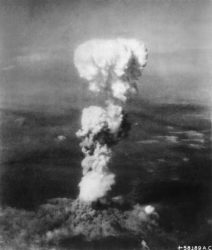
The atomic bomb cloud over Hiroshima Source: National Archives https://catalog.archives.gov/id/542192
Hiroshima before the war was the seventh largest city in Japan, with a population of over 340,000, and was the principal administrative and commercial center of the southwestern part of the country. As the headquarters of the Second Army and of the Chugoku Regional Army, it was one of the most important military command stations in Japan, the site of one of the largest military supply depots, and the foremost military shipping point for both troops and supplies.
Shortly afterwards, the White House released a statement from President Harry S. Truman that had been drafted while he was attending the Potsdam Conference. Truman called Hiroshima “an important Japanese army base.”
We are now prepared to obliterate more rapidly and completely every productive enterprise the Japanese have above ground in any city. We shall destroy their docks, their factories, and their communications. Let there be no mistake; we shall completely destroy Japan’s power to make war.
It was to spare the Japanese people from utter destruction that the ultimatum of July 26 was issued at Potsdam. Their leaders promptly rejected that ultimatum. If they do not now accept our terms they may expect a rain of ruin from the air, the like of which has never been seen on this earth. Behind this air attack will follow sea and land forces in such numbers and power as they have not yet seen and with the fighting skill of which they are already well aware.
Read: The Month That Changed the World for a timeline of events leading up to the end of World War II.
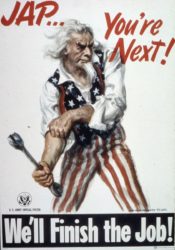
By June 1, Truman had apparently made his decision to use the atomic bomb to end the war with Japan. But the bomb had not yet been tested. Once the bomb had been successfully detonated in the New Mexico desert, the decision to use it moved forward, a fateful choice that was set against the recent American experience on Okinawa, where more than 12,500 Americans and more than 100,000 Japanese had died in brutal combat.
When the Japanese said they would fight to the death rather than make an unconditional surrender, the final decision was cast. Winston Churchill later summarized the decision: “To avert a vast, indefinite butchery.”
-From Don’t Know Much About the American Presidents

Aftermath of atomic bomb (Image: US Dept. of Energy”
After the war, a United States survey team assessed the impact of the Hiroshima bomb.
“Practically the entire densely or moderately built-up portion of the city was leveled by blast and swept by fire. A ‘fire-storm’, a phenomenon which has occurred infrequently in other conflagrations, developed in Hiroshima: fires springing up almost simultaneously over the wide flat area around the center of the city drew in air from all directions. The inrush of air easily overcame the natural ground wind, which had a maximum velocity of 30 to 40 miles per hour two to three hours after the explosion. The ‘fire-wind’ and the symmetry of the built-up center of the city gave a roughly circular shape to the 4.4 square miles which were almost completely burned out.
The surprise, the collapse of many buildings, and the conflagration contributed to an unprecedented casualty rate. Seventy to eighty thousand people were killed, or missing and presumed dead, and an equal number were injured. (Emphasis added)
What history has confirmed is that some of the men who created the bomb didn’t understand how horrifying its capabilities were. Of course, they understood the destructive power of the bomb, but radiation’s dangers were far less understood. As author Peter Wyden tells it in Day One, an account of the making and dropping of the bomb, scientists involved in creating what they called “the gadget” believed that anyone who might be killed by radiation would die from falling bricks first.
“The survivors, known as hibakusha, sought relief from their injuries. However, 90 percent of all medical personnel were killed or disabled, and the remaining medical supplies quickly ran out. Many survivors began to notice the effects of exposure to the bomb’s radiation. Their symptoms ranged from nausea, bleeding and loss of hair, to death. Flash burns, a susceptibility to leukemia, cataracts and malignant tumors were some of the other effects.
–“The Story of Hiroshima,” Hiroshima and Nagasaki Remembered
The heat was tremendous . And I felt like my body was burning all over. For my burning body the cold water of the river was as precious as the treasure. Then I left the river, and I walked along the railroad tracks in the direction of my home. On the way, I ran into an another friend of mine, Tokujiro Hatta. I wondered why the soles of his feet were badly burnt. It was unthinkable to get burned there. But it was undeniable fact the soles were peeling and red muscle was exposed.
—Mr. Akihiro Takahashi, who was 14 years old, when the bomb was dropped
On August 9, a second bomb, code named Fat Man, was detonated above Nagasaki.
Like Hiroshima, the immediate aftermath in Nagasaki was a nightmare. More than forty percent of the city was destroyed. Major hospitals had been utterly flattened and care for the injured was impossible. Schools, churches, and homes had simply disappeared. Transportation was impossible.
Many historians contend that preventing death and casualties in an invasion of Japan was only a partial explanation for the use of the two atomic bombs. The United States was already wary of Stalin and his designs on Japan’s wartime territory. They argue that the use of the two devices was meant to end the war quickly to prevent Stalin from capturing territory held by Japan. It may have also been a signal to Stalin and the Soviet Union –which had declared war on Japan and moved troops into Manchuria– that the United States possessed these weapons and was willing to use them.
In other words, the dropping of the atomic bombs became the first volley in the Cold War.
August 6 and 9 should not be days to argue about the politics of the bomb. They should be days of solemn remembrance of the victims. And of contemplating the horrific power of the weapons we create.
The City of Hiroshima Peace Memorial Park and Museum offers an English language website with a history of Hiroshima and the effects of the bombing.
Photo of what became later Hiroshima Peace Memorial among the ruins of buildings in Hiroshima, in early October, 1945, photo by Shigeo Hayashi. (Source Wikimedia Commons)
In 1939, physicist Albert Einstein had written a letter to President Franklin D. Roosevelt that resulted in the creation of the Manhattan Project that developed the atomic bomb. In 1948, Einstein was quoted by an interviewer as saying:
If I had foreseen Hiroshima and Nagasaki, I would have torn up my formula in 1905.
-Quoted in Einstein and the Poet : In Search of the Cosmic Man (1983) by William Hermanns
In 2016, President Barack Obama became the first sitting U.S. President to visit Hiroshima.
[8/2016 post updated 8/5/2022]
What was the Tonkin Resolution?

USS Maddox Operating at sea, circa the early 1960s. Official U.S. Navy Photograph, from the collections of the Naval History and Heritage Command
On August 5, 1964, President Lyndon B. Johnson put the Gulf of Tonkin Resolution before Congress. On August 7, Congress approved what soon became the legal foundation for Lyndon B. Johnson’s escalation of the Vietnam War.
It came in August 1964 with a brief encounter in the Gulf of Tonkin, the waters off the coast of North Vietnam where the U.S. Navy posted warships loaded with electronic eavesdropping equipment enabling them to monitor North Vietnamese military operations and provide intelligence to CIA-trained South Vietnamese commandos. One of these ships, the U.S.S. Maddox was reportedly fired on by gunboats from North Vietnam.
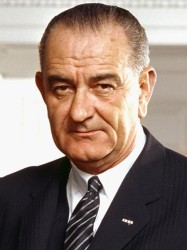
Lyndon B. Johnson (March 1964) Photo: Arnold Newman, White House Press Office
The reported attack came in the midst of LBJ’s 1964 campaign against hawkish Republican Barry Goldwater. President Johnson felt the incident called for a tough response and had the Navy send the Maddox and a second destroyer, the Turner Joy, back into the Gulf of Tonkin. A radar man on the Turner Joy saw some blips, and that boat opened fire. On the Maddox, there were also reports of incoming torpedoes, and the Maddox began to fire. There was never any confirmation that either ship had actually been attacked. Later, the radar blips would be attributed to weather conditions and jittery nerves among the crew.
According to Stanley Karnow’s Vietnam: A History,
“Even Johnson privately expressed doubts only a few days after the second attack supposedly took place, confiding to an aide, ‘Hell, those dumb stupid sailors were just shooting at flying fish.’”
Johnson ordered an air strike against North Vietnam and then called for passage of the Gulf of Tonkin Resolution. This legislation gave the president the authority to “take all necessary measures” to repel attacks against U.S. forces and to “prevent further aggression.” The resolution not only gave Johnson the powers he needed to increase American commitment to Vietnam, but allowed him to blunt Goldwater’s accusations that Johnson was “timid before Communism.”
The Gulf of Tonkin Resolution passed the House unanimously after only forty minutes of debate. In the Senate, there were only two voices in opposition. What Congress did not know was that the resolution had been drafted several months before the Tonkin incident took place. In June 1964, on LBJ’s orders, according to journalist-historian Tim Weiner,
“Bill Bundy, the assistant secretary of state for the Far East, brother of the national security adviser, and a veteran CIA analyst, had drawn up a war resolution to be sent to Congress when the moment was ripe.” (Legacy of Ashes: The History of the CIA, p. 280)
Congress, which has sole constitutional authority to declare war, had handed that power over to Johnson, who was not a bit reluctant to use it.
Testifying before the Senate, [Defense Secretary] McNamara lied, denying any American involvement in the Tonkin Gulf attacks: “Our Navy played absolutely no part in, was not associated with, was not aware of any South Vietnamese actions, if there were any.”
Three days after the announcement of the “incident,” the administration persuaded Congress to pass the Tonkin Gulf Resolution to approve and support “the determination of the president, as commander in chief, to take all necessary measures to repel any armed attack against the forces of the United States and to prevent further aggression” — an expansion of the presidential power to wage war that is still used regularly. Johnson won the 1964 election in a landslide.
–“The Secrets and Lies of the Vietnam War, Exposed in One Epic Document,” New York Times (June 9, 2021)
One of the senators who voted against the Tonkin Resolution, Oregon’s Wayne Morse, later said,
“I believe that history will record that we have made a great mistake in subverting and circumventing the Constitution.”
After the vote, Walt Rostow, an adviser to Lyndon Johnson, remarked,
“We don’t know what happened, but it had the desired result.”
In January 1971, Congress repealed the Gulf of Tonkin resolution as popular opinion grew against a continued U.S. military involvement in Vietnam
Since Vietnam, United States military actions have taken place as part of United Nations’ actions, in the context of joint congressional resolutions, or within the confines of the War Powers Resolution (also known as the War Powers Act) that was passed in 1973, over the objections (and veto) of President Richard Nixon.”
The War Powers Resolution came as a direct reaction to the Gulf of Tonkin Resolution, as Congress sought to avoid another military conflict where it had little input.
“The Gulf of Tonkin Resolution and the Limits of Presidential Power” National Constitution Center
In 2005, the National Security Agency (NSA) issued a report reviewing the Tonkin incident in which it said “no attack had happened.” (Weiner, p. 280)
The National Endowment for the Humanities website Edsitement offers teaching resources on Tonkin and the escalation of the Vietnam War.
Read more about Vietnam, LBJ and his administration in Don’t Know Much About® History, Don’t Know Much About® the American Presidents. The Vietnam War and the Tonkin Resolution are also covered in a chapter on the Tet offensive of 1968 in THE HIDDEN HISTORY OF AMERICA AT WAR.
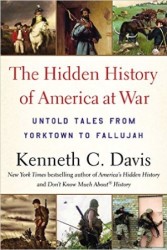
Now In paperback THE HIDDEN HISTORY OF AMERICA AT WAR: Untold Tales from Yorktown to Fallujah
(Originally posted on July 13, 2010; reposted July 11, 2022)
On July 11, 1863, the first Civil War draft lottery took place in New York City.
On July 13, 1863, New York City exploded in a four-day long murderous riot, still considered one of the deadliest urban riots in American history. The cause of the riots–violent opposition to the Civil War draft law.
Since poverty has been our crime,
We bow to the decree.
We are the poor who have no wealth
To purchase liberty.
If your picture of draft dodgers is one of 60s-era hippies shouting “Hell No, We won’t go,” the ditty above offers another vision.
It comes from the Civil War era, when the United States passed its first federal draft, the Enrollment Act, in March 1863. (A Confederate Draft had actually preceded the federal draft by two years.)
Under the rules of the law, there were certain exemptions –telegraph operators and railroad engineers were excused, as were certain government employees.
Then there were the rich. They were different. Under the terms of the Civil War draft, a man could avoid the draft by paying $300 or hiring a substitute. J.P. Morgan, Andrew Carnegie, and future President Grover Cleveland all did it. So did the wealthy father of Teddy Roosevelt.
The practice led to the complaint that the Civil War was “A rich man’s war, but a poor man’s fight.”
Coming on the heels of the Emancipation Proclamation announced in January 1863, the draft law was bitterly resented. By the summer of 1863 angry protests had taken place in nearly every union state. The headline of one Pennsylvania newspaper read: “WILLING TO FIGHT FOR UNCLE SAM BUT NOT FOR UNCLE SAMBO.”
And resistance to the draft soon turned ugly. Nowhere was the opposition greater or more violent than in New York City where Lincoln was despised by the powerful Democratic party which was openly critical of his administration. The working class Irish were particularly resentful of policies that allowed the wealthy to buy their way out of the draft, and they were hostile toward blacks, many of whom had been used to replace striking Irish longshoreman at New York’s docks.
The anger spilled over into violence in July 1863. On Saturday morning, July 11, the first draftees’ names were pulled in a lottery and announced. They were published alongside the casualty lists from the recent battle of Gettysburg, fought from July 1-3, 1863.
The following Monday, July 13, the draft office at Third Avenue and Forty-sixth Street was attacked by a mob of men armed with clubs who set the building afire. The fire brigade, angry that their jobs were not entitled to an official exemption, joined the mob instead of putting out the fire.
This was the beginning of a four-day spree of looting and arson that ended with murderous rioting.
Singled out for deadly attacks was the city’s black population. The rioters, many of them too young for the draft got caught up in the frenzy. Hundreds of mostly Irish rioters burned and pillaged their way down Third Avenue, en route to an armory where they seized hundreds of rifles. Another mob attacked an orphanage where black children lived. The anger boiled over into grotesquely savage atrocities. A crippled black coachman was lynched and his body burned. After his genitals were cut off, the mob dragged the body through the streets
One newspaper account published by the African Methodist Episcopal church, read:
“Many men were killed and thrown into the rivers, a great number were hung to trees and lamp-posts, numbers shot down; no black person could show their heads but that they were hunted like wolves. These scenes continued for four days.”
The riots left at least hundreds dead –some estimates range to two thousand—of course, most of them black. Order was eventually restored when troops arrived, some of them from West Point, others returning to New York from the Gettysburg battlefield.
Read more about the Draft Riots in DON’T KNOW MUCH ABOUT THE CIVIL WAR
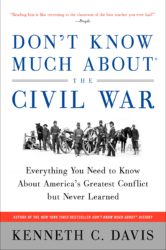
This post, originally dated May 08, 2009, was about the proposed New York City budget-cuts that have been a traditional problem for public libraries. However, in the current environment of political bloodletting, libraries and librarians have increasingly been threatened over the books they curate, as illustrated in this New York Times story, “With Rising Book Bans, Librarians Come Under Attack.”
In it, I wrote, “If education and information are going to provide the means as America digs itself out the great big hole we are in, the public library is handing out the shovels. Cut or kill the libraries and you yank away a shovel.”
In the age of disinformation and conspiracy theories dominating the media, the library is more essential than ever.
-Kenneth C. Davis July 6, 2022
Michael Bloomberg may be the ultimate IT Guy. Okay, maybe that’s still Bill Gates. But the point is, Michael Bloomberg took Information and Technology and made himself an empire with Bloomberg News. Then he became King of New York –or at least Mayor, and a very good one at that, as far as I am concerned.
So why would a man who built his world around IT want to cripple New York’s IT lifeline—the public library?
In case you haven’t heard, New York City’s public library systems –three separate library systems in Manhattan, Brooklyn and Queens—are once again under siege, on the chopping block , threatened with draconian cuts in the face of New York City’s Great Recession. (The cuts were outlined in an article in Library
Journal–http://www.libraryjournal.com/article/CA6656778.html)
Library cuts in down times remind me of the classic line from
Casablanca: “Round up the usual suspects.” The public library is always suspect Number One when it comes to municipal budget cuts. And as librarians everywhere know, this is not a fact in New York City alone.
Underlying this reality are two simple facts. First, libraries do not have a vocal, powerful constituency. Unlike the police, teachers and fireman, they don’t have a potent union or benevolent association. There is no “Library Lobby” doling out campaign contributions. But far worse, libraries tend to be viewed by all too many people in power as a luxury.
In many of these minds, the public library is stuck with an antiquated image of stern ladies shushing noisy kids, retirees borrowing the latest bestsellers and –more recently—homeless folk camping out in a heated corner. They are all clichés. And dumb ones at that.
I was in the bustling Mid-Manhatttan Library on Fifth Avenue recently. They had a line that the hot new Top Shop –along with all the mostly empty retailers on the street—would envy. Sure, some people were there to borrow books for free. But the public library, in case you haven’t been in one lately, is so much more than that—especially in these down times.
The public library is not just about borrowed books. It is about information –the great currency of our time. And the library has, by default, become the bridge in the digital divide because it offers free access to computers. Can you imagine in this digital day looking for a job, submitting a résumé or a college application, or searching for housing without your computer? For millions of people, the library is their laptop.
And it’s not just true in New York City. In Vermont, where the digital divide may be even greater due to economic disparity, the libraries are filled with people who need access to computers and are willing to wait for a turn. They have no choice.
Then there is education. The library is the crucial backstop to the educational system, far beyond the fundamental notion of being a “homework helper” for a school kid with a science project. From learning to read, or speak English, to having a decent place to do schoolwork or doing graduate research, the library is still a cornerstone of an educated, enlightened America.
For many people, the public library is also the visible face of the government. I’ve never been in City Hall, but I am in the library all the time. It is one functioning arm of the government that delivers a service efficiently, usually free of charge, and often with a smile and an offer of more help. Yes, librarians are NICE! Besides, when was the last time you saw a librarian being led away in handcuffs for taking bribes, fixing contracts or fudging the books?
And speaking of books. Books do change people. They can change society. Ask Harriet Beecher Stowe or Rachel Carson for starters. I could wax poetic about the importance that the public library played in my life. I’ll stop short and say that when I was growing up, the Mt. Vernon public library was as significant to me as church and school. Maybe even more.
If education and information are going to provide the means as America digs itself out the great big hole we are in, the public library is handing out the shovels. Cut or kill the libraries and you yank away a shovel.
Leave the libraries alone. Believe me. They are not a luxury, but a lifeline.
John Adams in a letter to Abigail Adams (July 3 1776)
But the Day is past. The Second Day of July 1776, will be the most memorable Epocha, in the History of America….It ought to be solemnized with Pomp and Parade, with Shews, Games, Sports, Guns, Bells, Bonfires and Illuminations from one End of this Continent to the other from this Time forward forever more.
(Source: Massachusetts Historical Society- Adams Electronic Archive)
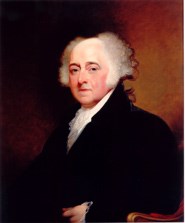
John Adams portrait by Gilbert Stuart
On July 2, 1776, the Second Continental Congress had passed a resolution of independence for America. The next day, Adams wrote to his wife expressing his optimistic view that the date would go down in history and be cause for great celebrations.
He was off by two days.
After considerable debate, Congress adopted Thomas Jefferson’s Declaration of Independence and July 4th was quickly established in the American imagination as “Independence Day.”
President Franklin D. Roosevelt, “D-Day Prayer” in an announcement to the nation of the invasion of Normandy (June 6, 1944)

Franklin D. Roosevelt in 1933
My fellow Americans: Last night, when I spoke with you about the fall of Rome, I knew at that moment that troops of the United States and our allies were crossing the Channel in another and greater operation. It has come to pass with success thus far.
And so, in this poignant hour, I ask you to join with me in prayer:
Almighty God: Our sons, pride of our Nation, this day have set upon a mighty endeavor, a struggle to preserve our Republic, our religion, and our civilization, and to set free a suffering humanity.
Lead them straight and true; give strength to their arms, stoutness to their hearts, steadfastness in their faith.
They will need Thy blessings. Their road will be long and hard. For the enemy is strong. He may hurl back our forces. Success may not come with rushing speed, but we shall return again and again; and we know that by Thy grace, and by the righteousness of our cause, our sons will triumph.
They will be sore tried, by night and by day, without rest-until the victory is won. The darkness will be rent by noise and flame. Men’s souls will be shaken with the violences of war.
Franklin Roosevelt’s D-Day Prayer Source: Franklin D. Roosevelt Library and Museum
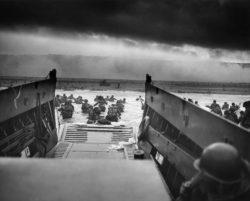
“Into the Jaws of Death – U.S. Troops wading through water and Nazi gunfire” by Robert F. Sergeant (National Archives)
In the largest amphibian assault in history, Allied armies crossed the English Channel to land on five beaches in Normandy in northern France. The invasion force involved 700 ships, 4,000 landing craft, 10,000 planes, and some 176,000 Allied troops from twelve countries. The allied forces were commanded by future President, Gen. Dwight D. Eisenhower.
The day was chaotic, brutal and bloody.
Steven Spielberg’s World War II epic, Saving Private Ryan, brought the reality of combat home to millions, but many moviegoers did not know which battle the film depicted, or when and why it happened. The assault, code-named Operation Overlord, occurred June 6, 1944, against Hitler’s Germany.
By the end of the day on June 6, 1944, the allies had taken all five beaches that had been targeted. The combined allied losses on that day have been recently stated at 4,415 dead, according to the National D-Day Memorial.
The German army did not formally surrender until May 7, 1945. May 8, 1945 was declared V.E. (Victory in Europe) Day.
More D-Day resources can be found at the FDR Library and Museum
Read more about FDR’s life and administration and World War II in Don’t Know Much About® History and Don’t Know Much About® the American Presidents

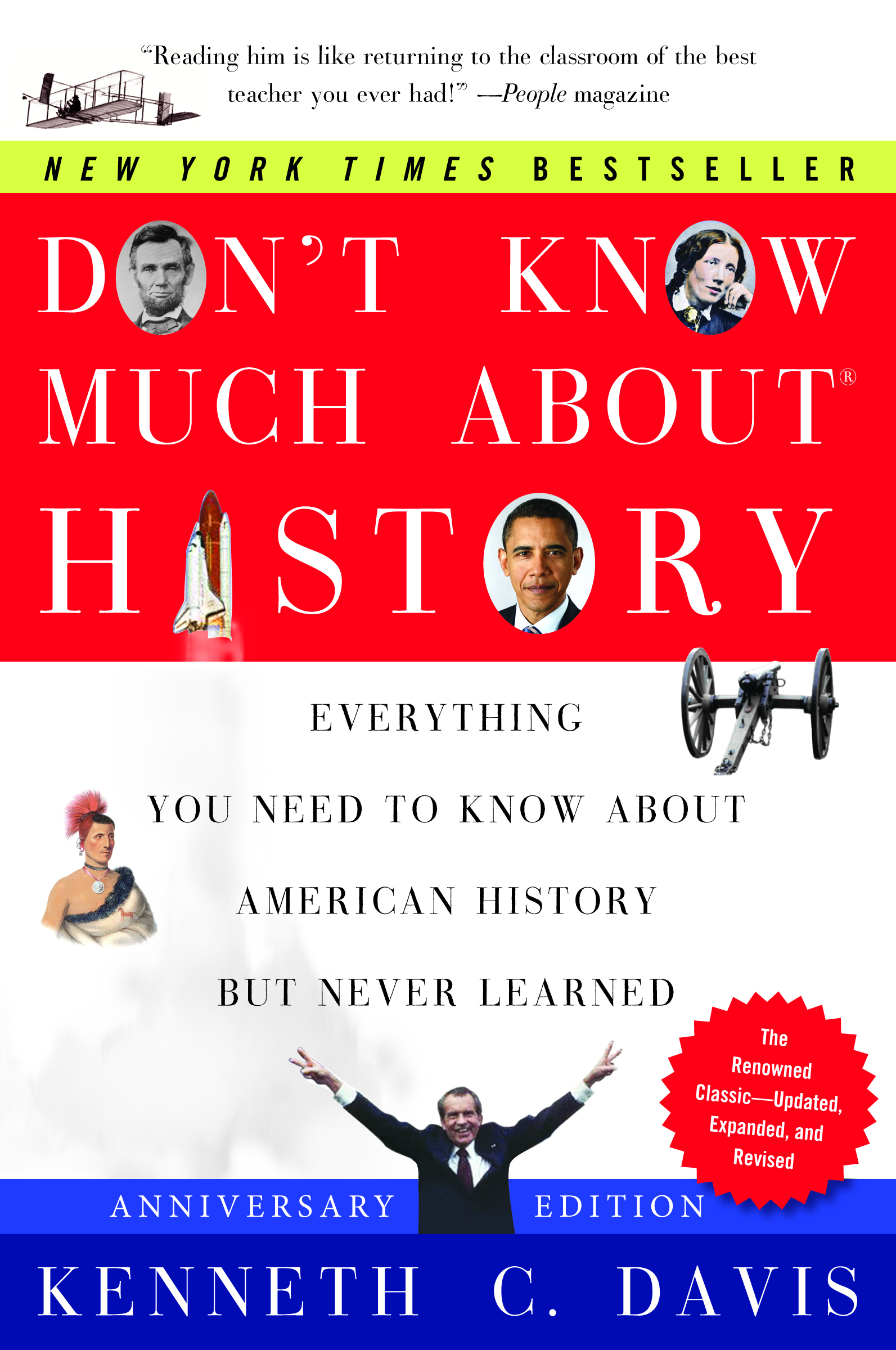
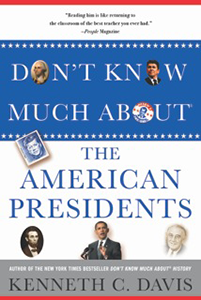
(May 2022 update of a 2015 post)
Why is there a statue of Benedict Arnold’s boot?
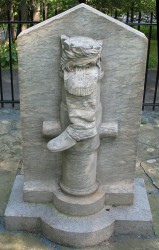
Statue of Benedict Arnold’s Boot at Saratoga National Historical Park
There it is — part of the Saratoga National Historical Park in Saratoga, New York. The “boot” is actually anonymous, citing the “most brilliant soldier in the Continental Army.”
On October 17, 1777, the British under General Burgoyne surrendered to American rebel troops led by Horatio Gates in one of the most significant turning points of the American Revolution.
But there is no question this marker honors American history’s greatest villain.
History books like to make people into heroes or villains. And Benedict Arnold was easily characterized as a villain, the most notorious traitor in American History for his attempt to betray the patriot cause when he was in command of the strategic post at West Point, overlooking the Hudson River. But he might have been one of the nation’s greatest heroes. And that is what makes history so compelling. Not the black and white of dates and “facts,” but the more subtle gray complexities of ego, ambition and human frailty.
Born on January 14, 1741 in colonial Norwich, Connecticut, Arnold had a biography that reads like that of a character out of Dickens. The son of a wealthy, successful ship’s captain and merchant, young Benedict Arnold was born with the proverbial silver spoon in his mouth. He was sent off to the best boarding school by his father, owner of the finest home in town. Then it fell apart. Yellow fever took his sisters while he was at school. Alcoholism then took his father. The fall was stunning as the elder Arnold became the town drunk and lost his fortune. At 14, young Benedict Arnold became an indentured servant. As a teenager, he ran away on several occasions to try and join the British-American forces then fighting France in the French and Indian War. Through pluck and generous relatives, Arnold eventually became a wealthy young merchant himself and was soon immersed in patriot politics, even traveling to Philadelphia to observe the First Continental Congress.
When the fighting began in 1775, he led Connecticut’s militia to Boston to join the rebel army gathering there. Arnold soon won honors for his role in the capture of Fort Ticonderoga on Lake Champlain on May 10, 1775. Cannons from Fort Ticonderoga were later taken to Boston by Henry Knox.
After Arnold’s treason, he was pretty much erased from this narrative and Ethan Allen worked hard to make sure he received complete credit. (Allen spent three years later as a British prisoner and even negotiated with the British for an independent Vermont. He later wrote a deist book attacking Christianity.)
With George Washington’s approval, Arnold went on to lead a daring but disastrous march through Maine to unsuccessfully attack Quebec.He was accompanied on that venture by a young Aaron Burr. History is constantly surprising and remarkable and often more intriguing than fiction.
Later, Arnold built a small navy to battle the British on Lake Champlain, helping save the patriot cause. But it was at Saratoga in October 1777 that he made his greatest contribution, leading a charge that turned the tide in what would become the most important American victory of the Revolution to that point.
During that charge, he was wounded in the leg and the injury caused a limp that would last his life. The statue recognizes Arnold’s wound and his central role in the victory at Saratoga without naming him.
Admired by Washington, Arnold also made a great many enemies. Seeing others promoted and advanced before him made him bitter and ultimately led to his fateful decision to join the British side.
After his plot was uncovered, Arnold did join the British side, fighting against his onetime countrymen. He led an assault on Virginia that nearly captured Governor Thomas Jefferson in 1781.
Arnold later moved to Canada and eventually to London where he died and was buried in June 1801 at the age of 60. His remains were accidentally –and fittingly?– moved to an unmarked grave.
You can read more about Arnold and his exploits in the chapter called “Arnold’s Boot” in America’s Hidden History and about the last day’s of the Revolution and Arnold’s role in The Hidden History of America at War.
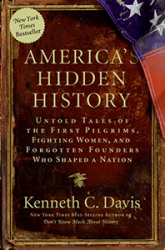
America’s Hidden History, includes tales of “Forgotten Founders”

The Hidden History of America At War (paperback)
Harry Truman, born on May 8, 1884, the 33rd President of the United States.
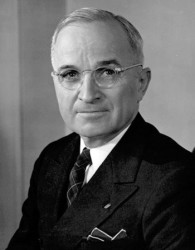
President Harry S. Truman
(Photo: Truman Library)
It was on his birthday in 1945 that Truman was able to tell Americans that the war in Europe was over with the surrender of Germany.
THIS IS a solemn but a glorious hour. I only wish that Franklin D. Roosevelt had lived to witness this day. General Eisenhower informs me that the forces of Germany have surrendered to the United Nations. The flags of freedom fly over all Europe. For this victory, we join in offering our thanks to the Providence which has guided and sustained us through the dark days of adversity.
Described as “a minor national figure with a pedestrian background,” Truman was a World War I veteran and a Senator from Missouri when Franklin D. Roosevelt chose him to become his running mate in the 1944 election. Truman became vice president when FDR won his fourth term and then took office on April 12, 1945 when FDR died.
When he took office, Truman had been largely left “out of the loop” by Roosevelt as World War II entered its final months. Truman did not know of the existence of the “Manhattan Project” and the development of the atomic bomb until he became president. Then he had to make the decision to use it against the Japanese.
Fast Facts
•Truman was a member of the Sons of the Revolution and the Sons of Confederate Veterans
•He wanted to attend West Point but poor eyesight kept him out. He enlisted in the Missouri National Guard and served as the commander of an artillery battery in World War I.
•Before entering politics, he was a farmer, bank clerk, insurance salesman and owner of a failed haberdashery store.
•As president he once threatened to punch the nose of a newspaper critic who had given his daughter a poor review after her debut singing recital. Margaret Truman went on to greater fame as a mystery novelist, beginning with Murder in the White House published in 1980.
Harry S. Truman died on December 26, 1972.
The Truman Library and Museum is located in Independence, Missouri
Read more about Truman, his life and administration in Don’t Know Much About® the American Presidents. Truman is also featured in the Berlin Battle chapter of The Hidden History of America at War.
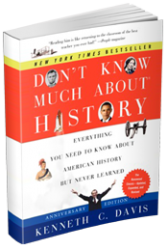
Don’t Know Much About History (Revised, Expanded and Updated Edition)

THE HIDDEN HISTORY OF AMERICA AT WAR: Untold Tales from Yorktown to Fallujah
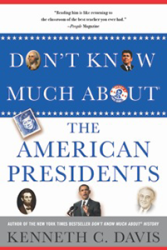
Don’t Know Much About® the American Presidents (Hyperion paperback-April 15, 2014)
Born on April 27, 1822 –2oo years ag0– the 18th President of the United States, Ulysses S. Grant

April 27, 1822 Born in Point Pleasant, Ohio
1839-1843 Attended West Point
1843-1853 Served in the Mexican War and a succession of U.S. Army posts, then resigned his commission.
1854-1858 Farmed near St. Louis, Missouri
1860-1861 Clerked in tannery store at Galena, Illinois
1861-1865 Served in Civil War; commanded all Union Armies
1869-1877 18thPresident
1880 Unsuccessful candidate for Republican presidential nomination
July 23, 1885 Died at Mt. McGregor, New York, aged 63
The country having just emerged from a great rebellion, many questions will come before it for settlement in the next four years which preceding Administrations have never had to deal with. In meeting these it is desirable that they should be approached calmly, without prejudice, hate, or sectional pride, remembering that the greatest good to the greatest number is the object to be attained.
This requires security of person, property, and free religious and political opinion in every part of our common country, without regard to local prejudice. All laws to secure these ends will receive my best efforts for their enforcement.
–Ulysses S. Grant, First Inaugural (March 4, 1869
The conquering hero of the Union, Ulysses S. Grant did not look the part. He was short, scruffy, favored enlisted men’s uniforms, and was dogged by reports of his fondness for drink –a somewhat undeserved reputation. Grant clearly was a drinker at times in his life, but the image of him as a stumbling drunk is a caricature. One successor, Theodore Roosevelt later called him, “The Hammer of the North,” and wrote,
“Grant’s supreme virtue was his doggedness….He was master of strategy and tactics, but he was also a master of hard-hitting. …His name is among the greatest in our history.”
There is no question that he was a dogged, determined general whose command skills helped win the war for the Union. Unfortunately, those strengths did not translate into the complexities of leading the large, swiftly growing, and rapidly changing nation. Another of his successors, James A. Garfield, who served on the battlefield under Grant, once said,
“He has done more than any other President to degrade the character of Cabinet officers by choosing them on the model of the military staff, because of their pleasant personal relationship to him and not because of their national reputation and public needs.”
Garfield was right. Personally honest, Grant was notoriously inept when it came to surrounding himself with men who were corrupt, both in private and as president. Some of them blackened his Presidency; others would reduce Grant to bankruptcy. Finally, a third later successor, Woodrow Wilson, once wrote of him, “The honest, simple-hearted soldier had not added prestige to the presidential office. He himself knew he had failed… that he ought never to have been made president.”
One reason that Grant has been positively reevaluated as President, however, was his commitment to achieving the vote for African Americans. In his 1874 Message to Congress, he said:
Treat the negro as a citizen and a voter, as he is and must remain, and soon parties will be divided, not on the color line, but on principle.
Religion: Methodist (Although raised Methodist, Grant never officially joined a church.)
Education: United States Military Academy (West Point)
Career before Politics: Soldier, farmer, leather shop clerk
Military Service: U.S. Army- Mexican War, Civil War
Political Party: Republican
First Lady: Julia Boggs Dent Grant (January 26, 1826-December 14, 1902) Grant’s best man was West Point classmate James Longstreet, later a Confederate general who attended Lee’s surrender in April 1865.
Children: Frederick, Ulysses S.Grant, Jr. (“Buck”), Ellen (“Nellie”), and Jesse Root Grant
Twelve years later, Grant’s Tomb was dedicated. Built with $600,000 donated by more than 90,000 people, it is the largest mausoleum in North America. Once again, more than one–million people attended the parade and dedication ceremony when Grant was interred in the tomb on April 27, 1897. Grant’s wife, Julia, was also interred –not buried—in Grant’s Tomb, after her death in 1902. It is the site of the General Grant National Memorial (NPS).
